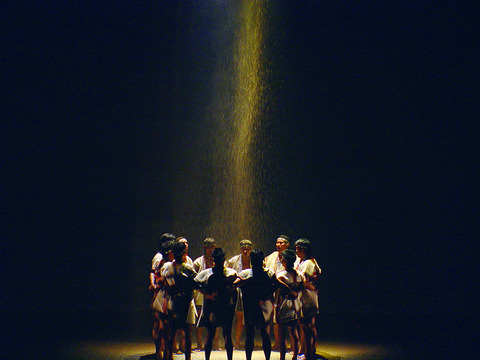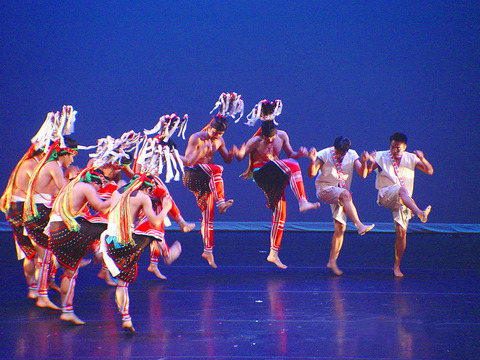With their imminent move to a new base in Hualien County, it will probably be a long while before Taiwan's foremost Aboriginal troupe, the Formosa Aboriginal Song and Dance Troupe (原舞者), stages another production in Taipei. This weekend's performances at the Novel Hall (新舞台) will also be a celebration of 15 years of endeavoring to preserve Taiwan's Aboriginal ritual traditions. The troupe will present the finest of the traditional songs and dances from six tribes epitomizing the multifarious tribal cultures and social changes that Taiwan's Aboriginal societies have undergone in their long history.
Aiming to preserve and revive the fast disappearing tribal songs and dances, the company was established by a group of young Aboriginals from different tribes in 1991. Part of their goal was to reverse the public's perception that Aboriginal dance was simply a tourist spectacle, bringing out the great ritual and social significance that these acts represent.
Over the years, the company not only has staged hundreds of performances touring around the country, but also holds workshops to re-ignite the interest of young Aboriginals' in traditional dance culture through reinterpretations and integration with contemporary theatrical elements. The troupe has gained considerable international recognition and has performed at art festivals in the US, Belgium, UK, Germany, France, Spain, Singapore and Hong Kong.

PHOTOS COURTESY OF FORMOSA ABORIGINAL SONG AND DANCE TROUPE
Each production is based on long-term field observations and participation. Assisted by anthropologists and tribal elders, troupe members and Aboriginal students are dispatched to different villages to study their rituals through the oral tradition. According to artistic director Faidaw Fangod, the duration of each visit to a village is limited to 10 days, to avoid disturbing the tribal life and traditions of their hosts.
“Take the Saisiyat tribe (賽夏族) for example. Their ceremonial songs and dances are regarded as sacred and there is a prohibition on public performance. Teaching outsiders like us thus poses a big challenge to them. We spent lots of time communicating with local residents until the tribal leaders agreed to let us study the rituals after many private meetings,” Fangod explained.
Since Aboriginal tribes exhibit great diversity in terms of language, culture and ritual, one of the biggest challenges for troupe members is to overcome the language barrier. “The tribes' phonic systems differ greatly and there is no unifying model for pronunciation. It's a painstaking task to learn the languages, let alone to familiarize oneself with the diverse ways of singing in different tribes,” said Fangod, an Amis from Taitung.

Featured in the current show is the highly acclaimed 1991 production of Legend of Mountains and Seas featuring the mayasvi ritual from the Tufuya village of the Tsou tribe (鄒族), who live deep in the mountains, and the ilisin ceremony from the coastal Amis tribe (阿美族).
Containing well-preserved ancient language elements whose meaning is no longer fully comprehensible, the mayasvi is a sacred ritual held each year after millet harvest to plead for gods' blessing on the tribe's solidarity, exorcising the evil spirits and paying respects to the dead. The Amis ilisin ritual is held at the end of each year to express gratitude to ancient spirits and supernatural powers. The event is always boisterous since Amis believes the grander the ceremony, the better the harvest in the coming year.
As for their own uncertain future in Hualien, the company's founder remains optimistic and positive. “It's a change of direction. We get to return to our lands and peoples and continue our work to preserve and pass down our cultural heritages,” said Fangod.

Most heroes are remembered for the battles they fought. Taiwan’s Black Bat Squadron is remembered for flying into Chinese airspace 838 times between 1953 and 1967, and for the 148 men whose sacrifice bought the intelligence that kept Taiwan secure. Two-thirds of the squadron died carrying out missions most people wouldn’t learn about for another 40 years. The squadron lost 15 aircraft and 148 crew members over those 14 years, making it the deadliest unit in Taiwan’s military history by casualty rate. They flew at night, often at low altitudes, straight into some of the most heavily defended airspace in Asia.

This month the government ordered a one-year block of Xiaohongshu (小紅書) or Rednote, a Chinese social media platform with more than 3 million users in Taiwan. The government pointed to widespread fraud activity on the platform, along with cybersecurity failures. Officials said that they had reached out to the company and asked it to change. However, they received no response. The pro-China parties, the Chinese Nationalist Party (KMT) and Taiwan People’s Party (TPP), immediately swung into action, denouncing the ban as an attack on free speech. This “free speech” claim was then echoed by the People’s Republic of China (PRC),

Many people in Taiwan first learned about universal basic income (UBI) — the idea that the government should provide regular, no-strings-attached payments to each citizen — in 2019. While seeking the Democratic nomination for the 2020 US presidential election, Andrew Yang, a politician of Taiwanese descent, said that, if elected, he’d institute a UBI of US$1,000 per month to “get the economic boot off of people’s throats, allowing them to lift their heads up, breathe, and get excited for the future.” His campaign petered out, but the concept of UBI hasn’t gone away. Throughout the industrialized world, there are fears that

Like much in the world today, theater has experienced major disruptions over the six years since COVID-19. The pandemic, the war in Ukraine and social media have created a new normal of geopolitical and information uncertainty, and the performing arts are not immune to these effects. “Ten years ago people wanted to come to the theater to engage with important issues, but now the Internet allows them to engage with those issues powerfully and immediately,” said Faith Tan, programming director of the Esplanade in Singapore, speaking last week in Japan. “One reaction to unpredictability has been a renewed emphasis on